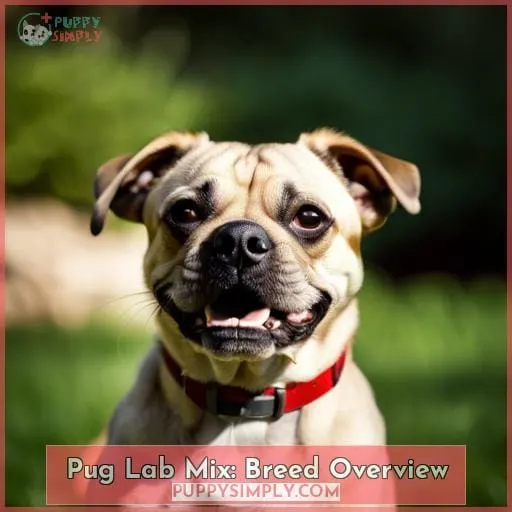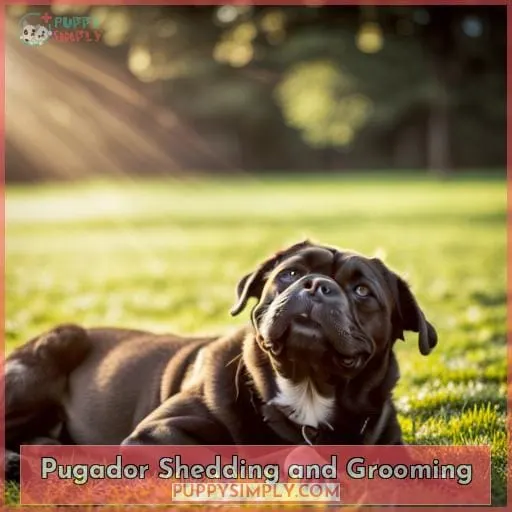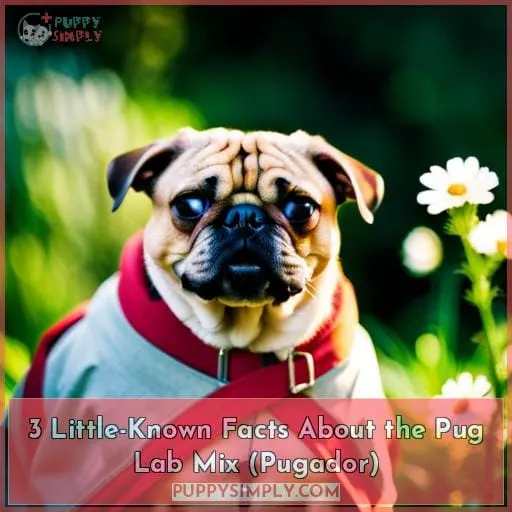This site is supported by our readers. We may earn a commission, at no cost to you, if you purchase through links.

Their appearance can vary, but they often inherit the Pug’s wrinkly face and the Labrador’s sleek coat. With proper exercise, training, and care, a Pugador can be a wonderful addition to your household.
There’s more to uncover about this enchanting crossbreed.
Table Of Contents
- Key Takeaways
- Pug Lab Mix: Breed Overview
- Origins and History
- Appearance and Grooming
- Temperament
- Exercise and Training
- Health and Care
- Pug Lab Mix Life Expectancy
- Pugador Shedding and Grooming
- Is a Pug Lab Mix Right for Me?
- 3 Little-Known Facts About the Pug Lab Mix (Pugador)
- Frequently Asked Questions (FAQs)
- Conclusion
Key Takeaways
- Unique mix of traits from Pug and Labrador breeds
- Prone to breathing issues and hip dysplasia, requiring regular vet visits
- Require an active lifestyle with daily exercise and consistent training
- Affectionate and playful, good with kids and other pets if socialized
Pug Lab Mix: Breed Overview
The Pugador is a loyal and affectionate designer breed that can range in appearance from the ancient pug to the more recently developed Labrador Retriever. This hybrid of two distinct parent breeds typically stands 15-20 inches tall and weighs between 25-50 pounds.
They have short coats that come in various colors, including black, chocolate, yellow, apricot, fawn, or silver.
It’s important to keep their facial folds clean daily too since this will help prevent any infections occurring due to moisture buildup there.
Pugadors are incredibly people-oriented dogs, which makes them great family pets as they love nothing more than being around humans! They’re also quite sensitive, so positive reinforcement training methods are recommended when teaching them new commands or tricks.
Despite having moderate exercise needs, these dogs still need at least one hour of physical activity every day with plenty of mental stimulation thrown into the mix too.
Though relatively healthy compared to many other breeds out there, Pugadors may still suffer from breathing difficulties due to their flat faces. Hip dysplasia and heart disease are also potential issues, so vet visits should be made regularly throughout their lifespan, which typically ranges from 10-14 years.
Looking after a Pug Lab Mix requires both physical and mental commitment, but if done correctly, you’ll soon find yourself with an ever-faithful companion who loves nothing more than spending quality time with you each day.
Origins and History
Discover the unique origins of this lovable pup, with one parent breed dating back centuries and another developed more recently. The Pugador is a hybrid mixing two distinct pedigree breeds – the ancient pug and the Labrador Retriever, which was first developed in the 1800s.
To ensure quality puppies, it’s important to seek reputable breeders who only use purebred parents for their litters. These breeders should have AKC recognized ancestry. Additionally, they should provide a healthy diet and early vet visits for the puppies.
Socialization and positive reinforcement training are also crucial. Furthermore, monitoring for exercise-related health problems is essential.
The temperament of these dogs is generally affectionate and loyal, with an endearing playfulness that can often lead to some mischievous behavior if left unchecked! They love nothing more than human interaction, so they thrive when surrounded by family members or friends.
Exercise needs are moderate, but daily physical activity should still be provided, along with plenty of mental stimulation. Food-motivated dogs like these may need careful monitoring regarding weight gain, however, due to their propensity towards overindulging treats! When cared for properly throughout its lifetime, a Pug Lab mix has an average lifespan between 10-14 years old – although breathing difficulties could occur earlier on due to any flat face inherited from its pug parent.
Appearance and Grooming
You’ll marvel at your pup’s unique appearance, with coat colors ranging from black and chocolate to yellow, apricot, or fawn. The Pugador Labradors have a short coat that requires weekly brushing to keep their fur looking healthy and glossy.
It is also important to clean the face folds of these dogs daily as this helps prevent infection caused by bacteria buildup.
Shedding is likely year-round for this breed, so regular baths may be needed too! The pug’s flat face can sometimes be passed on, which makes them all the more adorable, but it does come with certain health risks – such as breathing problems due to airway obstruction – that must always be kept in mind when caring for one of these delightful little companions!
Generally speaking, there are minimal differences between male and female lab mix puppies. However, boy pugs tend to be slightly larger than girls, with most standing between 15-20 inches tall at maturity and weighing 25-50 pounds depending on genetics.
Grooming your pet should remain an enjoyable experience for both you and your pup. Keeping him/her feeling happy throughout each session will help immensely! You could consider using special treats during grooming sessions to reward positive behavior while simultaneously reinforcing desired behaviors like sitting still or staying calm while having their nails trimmed, etc.
This breed loves attention, so don’t forget about some cuddles here and there too With consistent care, they look great all year round – just make sure not to overdo bathing frequency, as excessive stripping away natural oils can lead to skin irritation later down the line if left unchecked!.
Temperament
Your Pugador Lab Mix is an affectionate, loyal, and playful pup that loves human interaction. They are mischievous by nature, so it’s important to provide plenty of positive reinforcement when training your older dog.
Your pup will likely be between 15-20 inches tall at maturity with a weight ranging from 25-50 pounds depending on genetics.
In terms of temperament, the Labrador parent gives this mix a people-oriented personality, while the Pug breed adds its own unique traits such as being sensitive and loving companions who require extra care during grooming sessions due to their flat face shape.
This mixed breed requires moderate exercise needs with about 1 hour daily – but always keep an eye out for overheating and breathing issues since these dogs may struggle more than other breeds in hot weather conditions due to their short noses, making it difficult for them to take in enough oxygen efficiently.
They are intelligent yet sometimes stubborn pups that respond best when trained consistently with food motivation techniques like treats – just make sure not to overfeed your canine companion as they have higher risks associated with obesity compared to many other similarly sized breeds because of joint pain and hip dysplasia problems down the line if left unchecked!
As long as proper vet visits are made regularly throughout their lifespan (10–14 years) and healthy diet habits are kept in check, then overall health will be well taken care of with no problems.
Exercise and Training
Regular exercise and consistent training are key for keeping your pup happy, healthy, and well-behaved! When it comes to the Pugador Lab Mix breed specifically, they will need about one hour of moderate activity per day.
While this mixed breed inherits traits from both Labrador parents as well as its pug parent in terms of personality, they are people-oriented but can be stubborn if not trained properly.
- Keep an eye out for overheating issues due to their flat faces, which makes it difficult for them to take in enough oxygen efficiently.
- Positive reinforcement techniques, such as treats, work best during training sessions.
- Consistent socialization helps develop good behavior over time.
It’s also essential that regular vet visits are made throughout their lifespan (10–14 years) while maintaining healthy diet habits so that overall health stays intact without any problems down the line.
Health and Care
Caring for your pup’s health is essential to ensure a long and happy life, from regular vet visits to keeping an eye on diet. A Pugador Lab Mix is a mix of two pedigree breeds – the Pug and Labrador Retriever – so they have potential risks inherited from both parent breeds.
It’s important to know what those are when owning this family dog so you can take steps in ensuring their longevity.
This hybrid breed typically lives between 10-14 years. However, breathing problems may arise due to their flat faces. Make sure not to exercise them too much as it could lead to overheating because it limits how efficiently they can intake oxygen.
Healthy diets must be maintained with these puppies as well while monitoring weight closely. Food-motivated dogs need extra attention here since overfeeding could cause obesity, which puts strain on joints already at risk for arthritis or joint pain later in life! While brushing weekly helps keep shedding under control, regular baths help prevent skin infections associated with face folds common amongst pugs (especially during hot summer months).
Overall, by providing an adequate exercise schedule alongside healthy meals and occasional grooming sessions, we may stave off several unfortunate hereditary conditions that affect our beloved pets today without sacrificing quality time spent together either way!
Pug Lab Mix Life Expectancy
Nurturing your pup’s health is key to maximizing their lifespan – a Pugador Lab Mix could live up to 14 years with proper care! Caring for this hybrid breed involves watching out for potential hereditary conditions, providing adequate exercise and diet, as well as occasional grooming.
By understanding both parent breeds’ risks, you can monitor these issues accordingly. Pugs are prone to breathing problems due to their flat faces, while Labs have possibilities of heart disease or hip/elbow dysplasia.
Food-motivated puppies need extra attention here so they don’t become overfed and put strain on joints already at risk of arthritis or joint pain later in life.
Brushing weekly helps keep shedding under control, while regular baths prevent skin infections associated with face folds common amongst pug lab mix dogs, especially during hot summer months.
Exercise should be moderate considering this breed’s breathing constraints. An hour daily keeps them active without overheating due to the difficulty of taking in oxygen effectively through a short muzzle.
Socializing also plays an important role when it comes to staying true behaviorally.
With all these factors taken into account, we can ensure our beloved furry friend will get plenty of love throughout its lifetime by simply giving them what they require: healthy meals alongside quality playtime and proper hygiene maintenance routines every now and then too!
Pugador Shedding and Grooming
Your Pugador Lab Mix is an adorable hybrid of two much-loved breeds. They are incredibly loyal and affectionate. Their look ranges from the classic pug to that of a Labrador Retriever. They are medium-sized, standing at about 15-20 inches tall and weighing 25-50 pounds.
You’ll need to keep up with regular brushing for your pup’s coat, which can come in chocolate, yellow, or apricot colors, as well as black or fawn silver hues. There may also be visible mask patterning on its face from the pug parent, so don’t forget to clean those wrinkles daily.
While shedding is likely year-round due to both parents’ coats being short-furred varieties, baths should still have limited frequency depending on your individual dog’s needs.
Is a Pug Lab Mix Right for Me?
If you’re looking for a loving and loyal companion, a Pugador Lab Mix might be the perfect fit for you. This hybrid of two pedigree breeds is known to be people-oriented, intelligent, and affectionate.
It’s important to know what possible outcomes could come with this mix breed when it comes down to animal welfare and care considerations—especially since they’re not officially recognized by The American Kennel Club (AKC).
But if you understand the needs of these pug mix dogs before adopting one into your home, then owning a pup from this designer blend can bring much joy!
The best way to prepare yourself is by researching both parent breeds so as not to overlook any concerns or questions that may arise in the future. Knowing their temperament differences will help guide decisions about training methods while also helping socialize them properly early on in life.
With consistent reinforcement techniques such as positive reward systems applied during exercise routines, coupled with daily walks outdoors, should keep your pup active enough without overworking them too much due to its medium-sized body build.
Health-wise, it’s important that regular vet visits take place along with proper diet plans. The flat faces from its pug parent make some breathing issues more prone than most other dog types, which need extra monitoring.
Overall, though, there are many pros when considering getting one of these little bundles full of love: fun personalities combined with low-shedding coats make grooming fairly easy, requiring only weekly brushing sessions plus occasional baths depending on how dirty they get outside!
All things considered, understanding their needs ahead of time alongside providing ample amounts of attention throughout their lives would go a long way towards having an enjoyable furry friend who loves being around humans just like itself does!
3 Little-Known Facts About the Pug Lab Mix (Pugador)
Are you thinking of getting a Pug Lab Mix (Pugador)? Here are some little-known facts about this designer breed that might be helpful in making your decision.
First, the Labrador Retriever is more than just a bird dog; it was originally bred as an all-purpose waterfowl retriever.
Secondly, the pug has its roots in luxury and privilege, having been kept by Chinese emperors centuries ago.
Finally, these dogs have quite the celebrity following with famous fans such as Hugh Jackman and Ed Sheeran!
So if you’re wondering whether or not they’d make good family pets or get along easily with other animals – keep reading for answers to those important questions!
The Labrador is More Than a Bird Dog
You’ll be surprised to find that the Labrador is more than just a bird dog—it’s also an incredibly loyal and affectionate companion!
From their flat face inherited from the black lab parent, to yellow coats that can come from both lines, here are four true facts about Labradors:
- They have an even temperament suitable for all ages.
- They enjoy human interaction and need daily exercise.
- Potential health problems may arise due to flat faces or hip/elbow dysplasia risk.
- Siblings of the same litter will show different traits regardless of gender differences in this breed type.
The Labrador parent provides much-needed companionship with its gentle nature and loving spirit – making it the perfect pup for any family!
The Pug Started Out Living the Good Life
Experience the joy of having a loyal and loving companion with an interesting origin story—the Pugador! This hybrid breed is created from two distinct pedigree breeds: the pug and Labrador retriever.
The flat face characteristic comes more often from their pug parent, while coat colors such as black, chocolate, yellow, or apricot often come from their Labrador retriever parent. Their personality is mostly inherited through the fawn-colored pugs that have been known to be mischievous yet affectionate companions since ancient times.
They also take after their yellow Labrador counterpart in terms of being people-oriented and enjoying human interaction.
Throughout its lifespan, usually ranging between 10 to 14 years old, the Pugador enjoys human interaction and is a loving companion.
The Pug Has Fans in High Places
You’ll appreciate the pug’s popularity with royalty, celebrities, and everyday people alike! Adored for their playful personalities, small size, and screw tails, these dogs have been around since ancient times.
They remain popular pets due to puppy farmers supplying them at a glance. Furthermore, they make great therapy animals because of their weight; being light enough to be easily carried around in arms or bags.
Are These Dogs Good for Families?
The Pugador is a great family dog. It’s affectionate, loyal, and playful, making it an ideal pet for households with small children. This pup requires moderate exercise to stay healthy and active. Usually, daily walks or playtime in the yard will suffice.
They are also quite intelligent when it comes to training but can be stubborn at times, so consistency is key. As part of the sporting group, they require regular brushing due to their short coats, making them easy maintenance pets overall.
Does This Breed Get Along With Other Pets
With proper socialization, your Pugador will get along well with other pets in the home. These dogs are very people-oriented and usually love to join their owners on outdoor adventures. A litter of lab pug mix puppies can be a great way to introduce different dog breeds into an existing pet family.
The short coat of a pug is low maintenance yet sheds seasonally, so brushing them regularly helps keep shedding under control and maintains the structure of their fur.
Frequently Asked Questions (FAQs)
Is a Pug Lab Mix hypoallergenic?
No, a Pug Lab Mix is not hypoallergenic. This hybrid breed has short fur that sheds year-round and can cause allergies for some people. Regular brushing and occasional baths are recommended to keep shedding under control.
How much exercise does a Pug Lab Mix need?
A Pug Lab Mix requires about an hour of exercise daily. Monitor them for overheating and breathing issues, as they can be sensitive.
Does a Pug Lab Mix bark a lot?
A Pug Lab Mix may bark occasionally, but they are generally a quiet breed. They are alert and attentive to their environment, so they will let you know if something is amiss.
Are Pug Lab Mixes good with other pets?
Yes, Pug Lab Mixes are generally good with other pets. They are very social and loyal animals that enjoy the company of humans as well as their furry friends. With proper training and socialization from an early age, they can become great companions for other household pets.
How much do Pug Lab Mixes cost?
The cost of a Pug Lab Mix varies depending on where you purchase but can range from $400 to $ Quality breeders are typically more expensive than pet stores or shelters, and the costs may include vaccinations, spaying/neutering, and microchipping.
Conclusion
In short, the Pug Lab Mix, or Pugador, is a delightful hybrid pup that is sure to bring joy to any family. This loving, loyal, and playful pup will bring out the best in everyone. They are a medium-sized dog with a coat that can come in various colors, like black, chocolate, yellow, apricot, fawn, and silver.
They make wonderful family dogs, with their people-oriented personalities and easy trainability. It’s important to consider the potential health risks of the Pugador, such as breathing problems due to their flat face, and hip/elbow dysplasia.
With the right diet, regular vet visits, and daily exercise, your Pugador can live a long and happy life of 10-14 years.
If you’re looking for a pup that’s sure to bring lifelong joy and companionship, the Pug Lab Mix is the perfect choice!
















